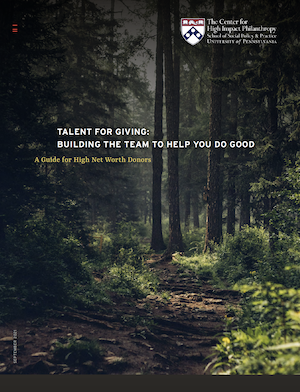Donors cannot achieve their intended social impact goals without help. But how can you identify the right team and talent to help you realize your impact goals?
Talent for Giving: Building the Team to Help You Do Good, A guide for high net worth donors, has answers on finding the people, talent, and networks to help you do more good with your giving.
Contents
Avoiding Philanthropy’s Talent Pitfalls
- We start with common misperceptions and myths that prevent donors from achieving the good they hope to create in the world. These pitfalls were reported in the literature, by nonprofit leaders, by longtime philanthropic advisors, by grantees, and by experienced donors themselves. Awareness of these pitfalls is the first step. You can avoid them by recognizing the capabilities required to do good and then sourcing talent from the broader talent ecosystem.
The Talent You Need for Greater Impact
The main body of this guide describes key inflection points along your giving journey when you need to find help and the sources and qualifications for the people who can help you move faster on the path to impact.
- Section 1: Talent to Help You Clarify Your Initial Goals and Approach
- Here we introduce the talent ecosystem from which you can source the help you need. We then discuss the early decisions you’ll need to make and what to look for in the people who can help you make those decisions well.
- Section 2: Talent to Implement Your Philanthropic Activities
- Once you have made early decisions regarding the cause areas you care about and the high-level approaches you want to fund, you will need help implementing. In this section, we define activities essential to strong implementation, including landscape scans, due diligence on people and organizations to fund, and grants management. We then describe the capabilities to look for in the people who will perform these activities, especially your first hire.
- Section 3: Talent to Help You Assess, Learn, and Improve
- Once you have funded activities designed to make progress toward social impact goals, you will need help understanding the results of those activities. You’ll need to compare actual activities to intended; measure results; capture lessons learned; and set goals for your next cycle.

